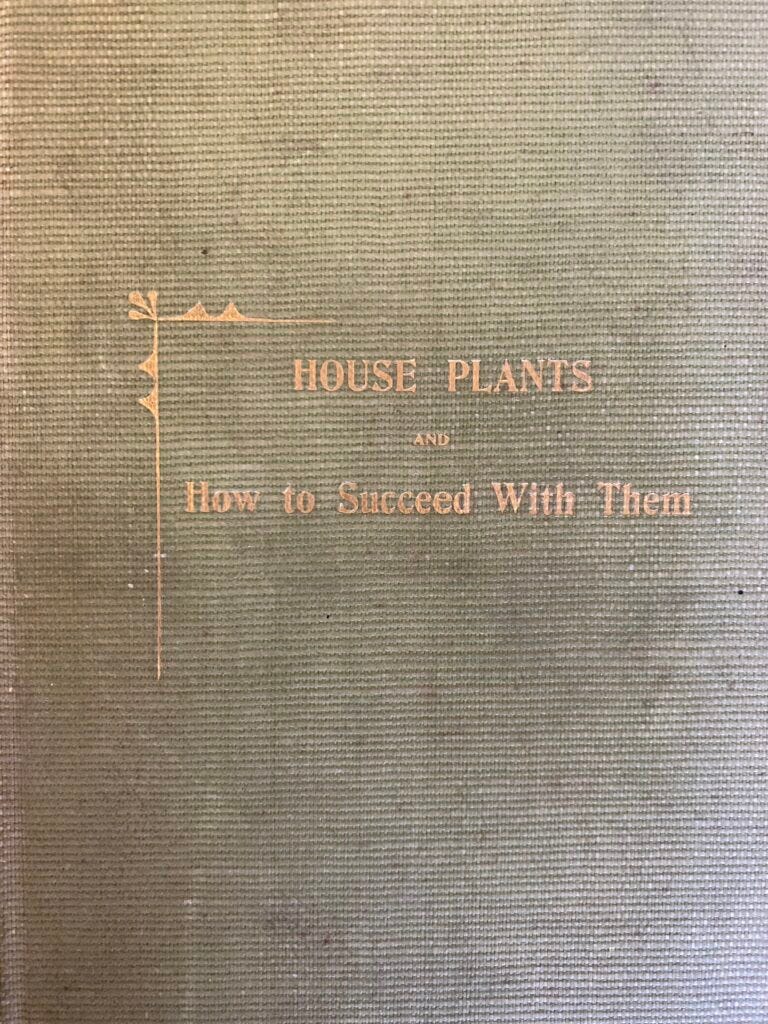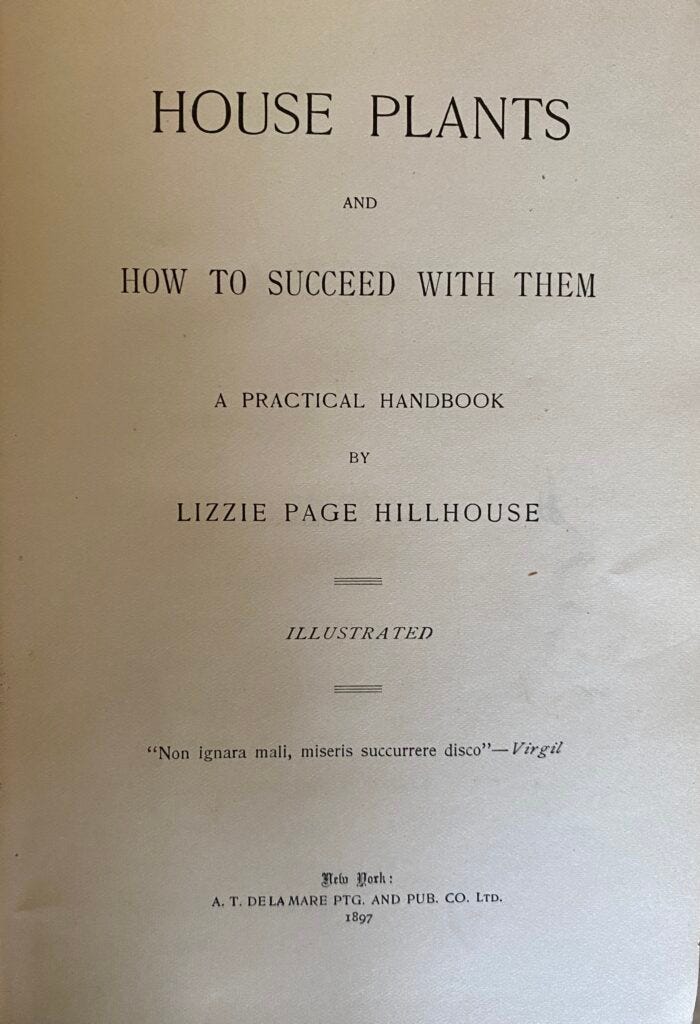Happy “Houseplant Appreciation Day” on January 10th!
In honor of the day, shall we discuss a lost lady of garden writing who wrote a book about houseplants in the 19th century?
I’m sure Lizzie Page Hillhouse, author of House Plants and How to Succeed With Them (A.T. de la Mare Ptg. and Pub. Col. Ltd., 1897), would be pleased that we are all enjoying houseplants so much these days.
We can now honor her by learning about her contributions to help us be successful with them.
Lizzie’s book arrived on my doorstep courtesy of a friend who was cleaning out her library and decided this book needed a new home. And that home was my library. I was pleased to take it in, dust it off, and then head off down two rabbit holes. Who was Lizzie Page Hillhouse, and how did they tend house plants 125 years ago?
Lizzie’s Biography
My first searches on ancestry.com and newspapers.com, didn’t tell me much about Lizzie, though I did learn that Lizzie was a common first name in the 1800s and “Page” isn’t that extraordinary. I found myself making a few wrong turns because of those two names, often running into the wrong Lizzie. But I think I found the correct one eventually.
Lizzie appears to have lived most of her life in New Brunswick, New Jersey, home of Rutgers University. My brief search leads me to believe that Lizzie was never a student there.
In the 1870 census records, Lizzie was 15 years old, so she was probably born in 1855. But, in the 1900 census, Lizzie, who was by then married to Mansfield L. Hillhouse, a lawyer, was listed as being born in 1860, in Texas of all places. Was that because Mansfield’s birth year recorded in the 1900 census was 1858? Perhaps Lizzie didn’t want to be older than her husband?
Even with the birth year discrepancy, I still think I found the right Lizzie.
What convinced me that I had the right Lizzie was when I found a copy of Lizzie’s will, which was put into probate in 1902, so I presume that’s the year she died. She was either 42 or 47 at the time of her death. I can find no other records about her dated later than 1902.
A Fund in Her Honor
Most of the newspaper mentions I found were about her book, House Plants and How to Succeed With Them, which usually sold for one dollar, $36 in today’s dollars.
I also discovered via one newspaper article that her sister gave $5,000 to the Children’s Industrial Home of New Brunswick, NJ in September 1902 in memory of her sister.
It was known as the Lizzie Page Hillhouse Memorial Fund, but I found nothing more about the fund and didn’t try to find out more about the Children’s Industrial Home of New Brunswick, though I did find some images of postcards showing it as large, stately building.
I am curious why Lizzie was “deeply interested in the home,” and what kind of home it was—it doesn’t sound like a nice place to me— but that’s a search I’ll have to take up some other day.
I did wonder what amount Mrs. Collis P. Huntington would have to donate today to make a similar donation. The answer? An astounding $184,123.
About the Book
On to the book!
The title page of the book includes a phrase in Latin.
Non ignara mali miseris succurrere disco ~ Virgil.
Translated it is, “No stranger to misfortune myself, I have learned to relieve the sufferings of others.”
I suspect no other houseplant book offers that quote on the title page. Does it refer to Lizzie suffering from misfortunes of some kind? Or does it refer to the many house plants she killed as she figured out how to keep them growing, and now she was passing on her knowledge to others?
Though I’ve not yet read the entire book—it takes a bit of concentration to read a book written in 1897—I’ve looked through enough of it to discover that Lizzie loved plants and loved to overwinter many plants, which she did by bringing them into her house during cold weather.
Other times, she carefully overwintered the plants or bulbs in a sheltered spot until she could bring them inside where they’d grow and flower in the warmth and light.
She also included instructions for how to force Lily of the Valley into bloom in the wintertime, something I’ve done a few times myself.
House Plants and How to Succeed With Them is illustrated with one photograph (of tulips in a vase) and several black & white drawings such as this one of lily of the valley.
If you’d like to read it without buying an original copy or a reprint, you can do so online at Google Books.
And congratulations to Lizzie because I think her book had a second edition or print run in 1899.
Regardless of whether or not she lied about her age and even though she probably wrote just this one book, Lizzie is a welcome addition to the Lost Ladies of Garden Writing, with her book, House Plants and How to Succeed With Them.
(I originally wrote about Lizzie on my blog in November 2022.)








